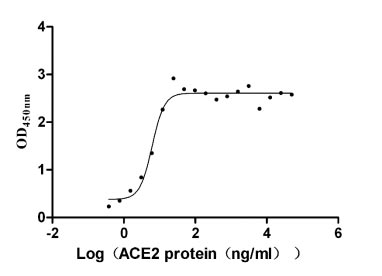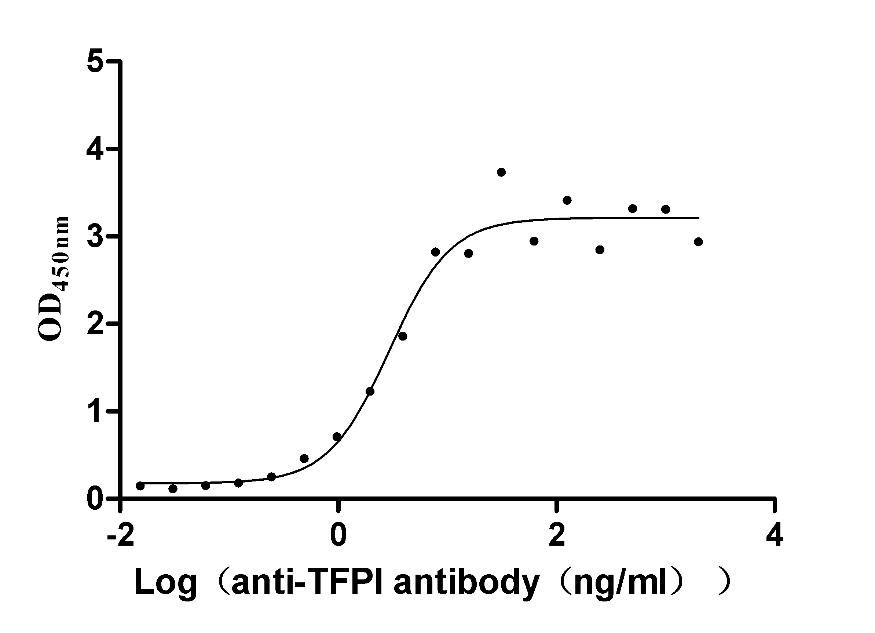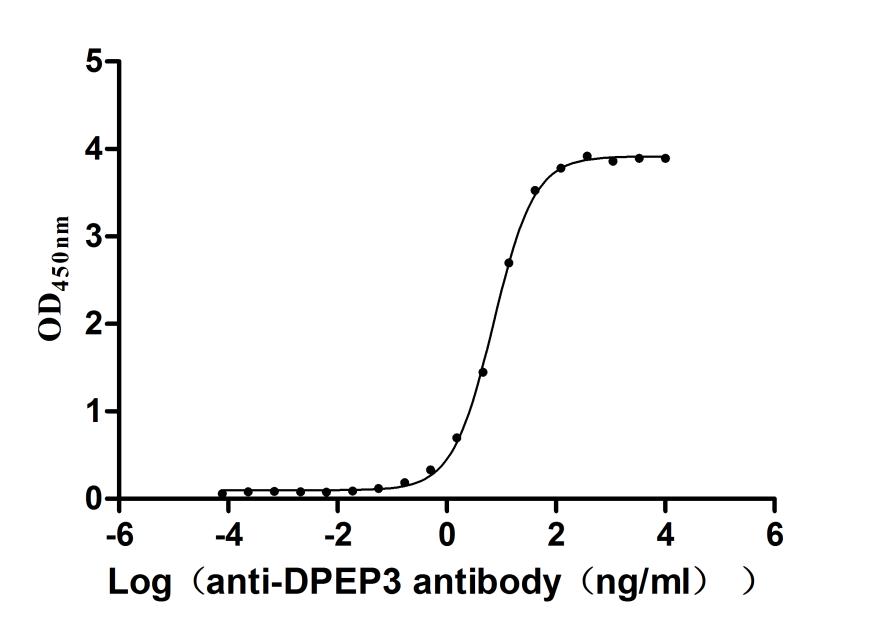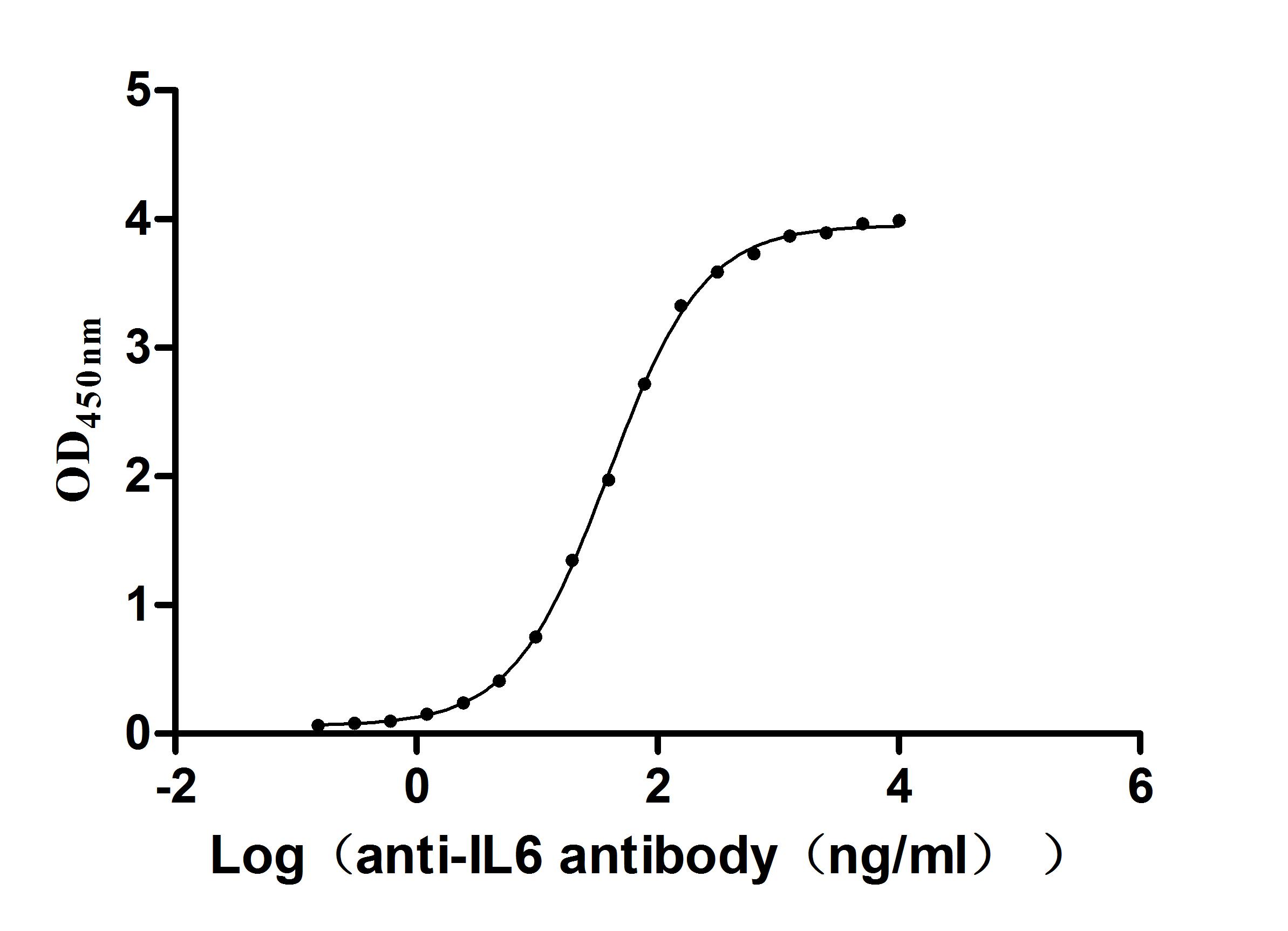Recombinant Mouse C-X-C chemokine receptor type 3 (Cxcr3), partial
-
中文名稱:Recombinant Mouse C-X-C chemokine receptor type 3(Cxcr3), partial,Yeast
-
貨號:CSB-YP006253MO1
-
規(guī)格:
-
來源:Yeast
-
其他:
-
中文名稱:Recombinant Mouse C-X-C chemokine receptor type 3(Cxcr3), partial,Yeast
-
貨號:CSB-EP006253MO1-B
-
規(guī)格:
-
來源:E.coli
-
共軛:Avi-tag Biotinylated
E. coli biotin ligase (BirA) is highly specific in covalently attaching biotin to the 15 amino acid AviTag peptide. This recombinant protein was biotinylated in vivo by AviTag-BirA technology, which method is BriA catalyzes amide linkage between the biotin and the specific lysine of the AviTag.
-
其他:
-
中文名稱:Recombinant Mouse C-X-C chemokine receptor type 3(Cxcr3), partial,Yeast
-
貨號:CSB-BP006253MO1
-
規(guī)格:
-
來源:Baculovirus
-
其他:
-
中文名稱:Recombinant Mouse C-X-C chemokine receptor type 3(Cxcr3), partial,Yeast
-
貨號:CSB-MP006253MO1
-
規(guī)格:
-
來源:Mammalian cell
-
其他:
產(chǎn)品詳情
-
純度:>85% (SDS-PAGE)
-
基因名:Cxcr3
-
Uniprot No.:
-
別名:Cxcr3; Cmkar3; C-X-C chemokine receptor type 3; CXC-R3; CXCR-3; Interferon-inducible protein 10 receptor; IP-10 receptor; CD antigen CD183
-
種屬:Mus musculus (Mouse)
-
蛋白長度:partial, the first extracellular domain
-
蛋白標簽:Tag?type?will?be?determined?during?the?manufacturing?process.
The tag type will be determined during production process. If you have specified tag type, please tell us and we will develop the specified tag preferentially. -
產(chǎn)品提供形式:Lyophilized powder
Note: We will preferentially ship the format that we have in stock, however, if you have any special requirement for the format, please remark your requirement when placing the order, we will prepare according to your demand. -
復溶:We recommend that this vial be briefly centrifuged prior to opening to bring the contents to the bottom. Please reconstitute protein in deionized sterile water to a concentration of 0.1-1.0 mg/mL.We recommend to add 5-50% of glycerol (final concentration) and aliquot for long-term storage at -20℃/-80℃. Our default final concentration of glycerol is 50%. Customers could use it as reference.
-
儲存條件:Store at -20°C/-80°C upon receipt, aliquoting is necessary for mutiple use. Avoid repeated freeze-thaw cycles.
-
保質(zhì)期:The shelf life is related to many factors, storage state, buffer ingredients, storage temperature and the stability of the protein itself.
Generally, the shelf life of liquid form is 6 months at -20°C/-80°C. The shelf life of lyophilized form is 12 months at -20°C/-80°C. -
貨期:Delivery time may differ from different purchasing way or location, please kindly consult your local distributors for specific delivery time.Note: All of our proteins are default shipped with normal blue ice packs, if you request to ship with dry ice, please communicate with us in advance and extra fees will be charged.
-
注意事項:Repeated freezing and thawing is not recommended. Store working aliquots at 4°C for up to one week.
-
Datasheet :Please contact us to get it.
相關產(chǎn)品
靶點詳情
-
Receptor for the C-X-C chemokine CXCL9, CXCL10 and CXCL11 and mediates the proliferation, survival and angiogenic activity of mesangial cells through a heterotrimeric G-protein signaling pathway. Probably promotes cell chemotaxis response. Binds to CCL21.
-
基因功能參考文獻:
- The data illustrate the paradoxical pro-tumor role for CXCR3 in lung immunobiology wherein the CXCR3 axis drives both the anti-tumor effector cell chemoattraction and pro-tumor infiltration of the lungs and suggests a potential therapeutic target for lung-tropic metastasizing cancers. PMID: 28358049
- the data suggest that CXCR3 and the integrin alpha4 mediate T cell recruitment to uninfected salivary glands but that redundant mechanisms mediate T cell recruitment after Murine Cytomegalovirus infection. PMID: 29288198
- The data of this study suggested that spinal CXCR3 mediates chronic itch and alloknesis, and targeting CXCR3 may provide effective treatment for chronic pruritus. PMID: 28401489
- Study provided the evidence that CXCL10/CXCR3 signaling in periaqueductal gray is involved in the development of morphine analgesic tolerance via neuron-microglia interaction. PMID: 28755808
- The results demonstrate that the recruitment of peripheral immune cells into the CNS, induction of neuroinflammation, and consecutive weight loss during herpes encephalitis is modulated by CXCR3 signaling. PMID: 28116674
- results show an important role for CXCR3 and CXCL10 in the tissue distribution of preimmune memory phenotype CD8 T- cells PMID: 29187588
- Our data suggests that the altered gene profiles induced by CXCR3 deficiency promotes autoimmune cholangitis through pathogenic CD8(+) T cells. PMID: 28129932
- Data suggest that the CXCL9-CXCR3 axis plays a pivotal role in the liver-specific distribution of TRAIL+ NK cells in mice. PMID: 29088306
- study thus shows that lung mucosal-resident memory T cells are not generated following systemic TB immunization and that local inflammation is required for systemically activated T cells to home to lung mucosa, which is mediated by interaction between CXCR3 upregulated in these cells and its ligands IP-10 and MIG PMID: 28827285
- Antigen targeting to DEC-205 on dendritic cells leads to an IL-10-dependent downregulation of CXCR3 expression on differentiated antigen-specific Th1 cells in vivo. This downregulation interferes with the migration of Th1 cells into the gut and protects mice against severe acute and relapsing intestinal inflammation. PMID: 26732675
- this study shows that neutrophils and NK cells act as important disease-promoting immune cells in experimental osteoarthritis and their functional interaction is promoted by the CXCL10/CXCR3 axis PMID: 28108560
- These results demonstrate a critical role for both BLT1 and CXCR3 in cytotoxic T lymphocyte (CTL) migration to tumors and thus may be targeted to enhance efficacy of CTL-based immunotherapies. PMID: 27465528
- Our studies suggest that CXCR3 is a key contributor to the pathogenesis of Alopecia areata by mediating the infiltration of autoreactive CD8+NKG2D+ T cells into the skin PMID: 27412416
- Cxcr3 is up-regulated by DNA demethylation and interaction with C/EBPalpha which contributes to neuropathic pain. PMID: 28100749
- These findings demonstrate that the CXCL10/CXCR3 chemokine pathway is critical in shaping CD8(+) T cell immunity, locally within latently infected tissues, which protects against recurrent herpesvirus infection and disease. PMID: 28468883
- this study shows that although T cell-specific expression of CXCR3 promotes the accumulation of CXCR3-expressing T cells during Leishmania donovani infection, this does not enhance resistance to visceral leishmaniasis; hepatic granuloma formation is impaired in CXCR3 transgenic mice PMID: 27614845
- up-regulated in sepsis-induced acute lung injury PMID: 27565063
- beta4GalT1 can regulate N-glycans of CXCR3 in RA. N-glycans of CXCR3 affects CXCL10/CXCR3 ligand-binding which enhancing fibroblast-like synoviocytes invasion. PMID: 28215986
- this study shows that diosgenin-mediated anti-allergic effects are associated with increased number of Foxp3+ Treg cells expressing CXCR3 PMID: 27886644
- Circulating levels of chemokines that activate CXCR3 are elevated in non-obese diabetic (NOD) mice, consistent with clinical findings in human diabetes. PMID: 27325565
- CXCR3 interacts with IL-10 secreted by CD8+CD122+ regulatory T cells in a mouse model of Acute Lung Injury and promotes interferon-gamma and CXCL10 release. PMID: 26475448
- This study demonstrates a previously unrecognized role of CXCR3 signaling in glial cells in negatively regulating Th17 cell expansion during experimental autoimmune encephalomyelitis PMID: 27068264
- CXCR3 was also linked to steatosis through inducing hepatic lipogenic genes PMID: 26394162
- findings demonstrate that targeting CXCR3 is effective in both tumor and host compartments, and suggest that CXCR3 inhibition is likely to avoid adverse effects on host cells PMID: 26485767
- Activation of the CXCL10/CXCR3 pathway has an important role in retinal inflammation and neuronal injury after high intraocular pressure-induced ischemia. PMID: 26448323
- STAT3 in CD8+ T Cells Inhibits Their Tumor Accumulation by Downregulating CXCR3/CXCL10 Axis PMID: 26025380
- CXCR3-mediated trafficking of regulatory T cells could represent a mechanism of homeostatic immunoregulation during diabetogeneesis. PMID: 25946021
- These studies identify CXCR3-mediated trafficking at the tumour vascular interface as a critical checkpoint to effective T-cell-based cancer immunotherapy. PMID: 26109379
- activated T cells display a subtle distance-dependent chemotaxis toward clusters of infected cells and this is mediated by CXCR3 and its ligands. PMID: 26525288
- results suggest that CXCR3 plays an important role in recruiting proinflammatory cells to the colon during colitis and that CXCR3 may be a therapeutic target to reduce the influx of proinflammatory cells in the inflamed colon. PMID: 24992040
- MOG(1-125) immunization resulted in an increased incidence of severe experimental autoimmune encephalomyelitis and was accompanied by an increased percentage of CXCR3-expressing CD4+ T cells producing IFNgamma in the CNS. PMID: 24552747
- Data indicate that dipeptidylpeptidase 4 (DPP4) diminishes chemokine CXCL10 expression and limits CXC Chemokine Receptor 3 (CXCR3)-mediated antitumor immunity. PMID: 26075911
- Maternal CD8+ T cells with fetal specificity upregulated expression of the chemokine receptor CXCR3 and were essential for L. monocytogenes-induced fetal resorption in prenatal L. monocytogenes infection. CXCR3 knockout or blockade prevented this. PMID: 25751061
- The anti-fibrotic effects of CXCL10 in the healing infarct and in isolated cardiac fibroblasts are CXCR3-independent and may be mediated through proteoglycan signalling PMID: 24891401
- CXCR3-dependent recruitment of cells to inflamed areas was critical for development of the CD8-positive, CD103-negative T lymphocyte population and pathogen clearance. PMID: 25706747
- CXCR3 enables local CD8(+) T cell migration for the destruction of virus-infected keratinocytes. PMID: 25769612
- CXCR3 signaling mediates development of Alzheimer disease-like pathology in APP/PS1 mice. PMID: 25500888
- The CXCR3 chemokine system is critically involved in the intrinsic glial activation during cuprizone-induced demyelination, which significantly modulates the distribution of glial cells and the local cytokine milieu. PMID: 24930935
- plays a role in insulin resistance and obesity-induced visceral adipose inflammation PMID: 24124129
- this is the first report that demonstrates a role for CXCR3 in macrophage polarization and subsequent breast tumor outcomes PMID: 24679047
- In our mouse model, fatal progression of AIH is mediated by IL-18-dependent differentiation of T cells into Th1 cells and effector T cells, respectively, and that CXCR3-CXCL9 axis-dependent migration of those T cells is crucial for fatal progression. PMID: 24700550
- CXCR3 contributes to T-cell accumulation in periepididymal adipose of obese mice. PMID: 24812325
- CCR4 and CXCR3 play different roles in the migration of T cells to inflammation in skin, arthritic joints, and lymph nodes. PMID: 24700244
- CXCR3 is critical to the skin-selective effector T-cell recruitment underlying autoreactive GVHD PMID: 24390137
- Data indicate that NOD2 is required for CXCR3-dependent small intestinal (SI) CD8(+) T cell migration during T cell activation. PMID: 24591373
- results establish a central role for CXCR3 in coordinating innate and adaptive immunity, ensuring generation of Th1 effectors and their trafficking to the frontline of infection to program microbial killing by inflammatory monocytes. PMID: 24130498
- blockade or genetic deficiency of either CXCR3 or of its primary ligand has no impact on clinical experimental autoimmune encephalomyelitis induced by the adoptive transfer of highly polarized Th1 effector cells. PMID: 23873018
- The data show that CCL21 and CXCR3 have dichotomous functions in traumatic and autoimmune encephalomyelitis-evoked neuropathic pain suggesting PMID: 23643685
- Expression of the chemokine receptor CXCR3 was critical for memory CD8(+) T cells to populate the airways during the steady state. IL-12 signaling shortly after immunization limited CXCR3 expression on memory CD8(+) T cells. PMID: 24238342
- early differentiated CD138(high)MHCII(+) rather than terminally differentiated CD138(high)MHCII(low) plasma cells may be involved in the renal inflammatory injury in lupus, due to CXCR3 expression and IgG secretion. PMID: 23520491
顯示更多
收起更多
-
亞細胞定位:Cell membrane; Multi-pass membrane protein.
-
蛋白家族:G-protein coupled receptor 1 family
-
組織特異性:Expresses in lymphoid organs and Th1 cells.
-
數(shù)據(jù)庫鏈接:
Most popular with customers
-
Recombinant Paguma larvata Angiotensin-converting enzyme 2 (ACE2), partial (Active)
Express system: Mammalian cell
Species: Paguma larvata (Masked palm civet)
-
Recombinant Human Neuropilin-1 (NRP1) (Active)
Express system: Mammalian cell
Species: Homo sapiens (Human)
-
Recombinant Rabbit Tissue factor pathway inhibitor (TFPI) (Active)
Express system: Mammalian cell
Species: Oryctolagus cuniculus (Rabbit)
-
Recombinant Rat Intestinal-type alkaline phosphatase 1 (Alpi) (Active)
Express system: Mammalian cell
Species: Rattus norvegicus (Rat)
-
Recombinant Human Killer cell immunoglobulin-like receptor 3DL2 (KIR3DL2), partial (Active)
Express system: Mammalian cell
Species: Homo sapiens (Human)
-
Recombinant Human Carcinoembryonic antigen-related cell adhesion molecule 8(CEACAM8) (Active)
Express system: Mammalian cell
Species: Homo sapiens (Human)
-
Recombinant Human Dipeptidase 3(DPEP3), partial (Active)
Express system: Mammalian cell
Species: Homo sapiens (Human)
-




















